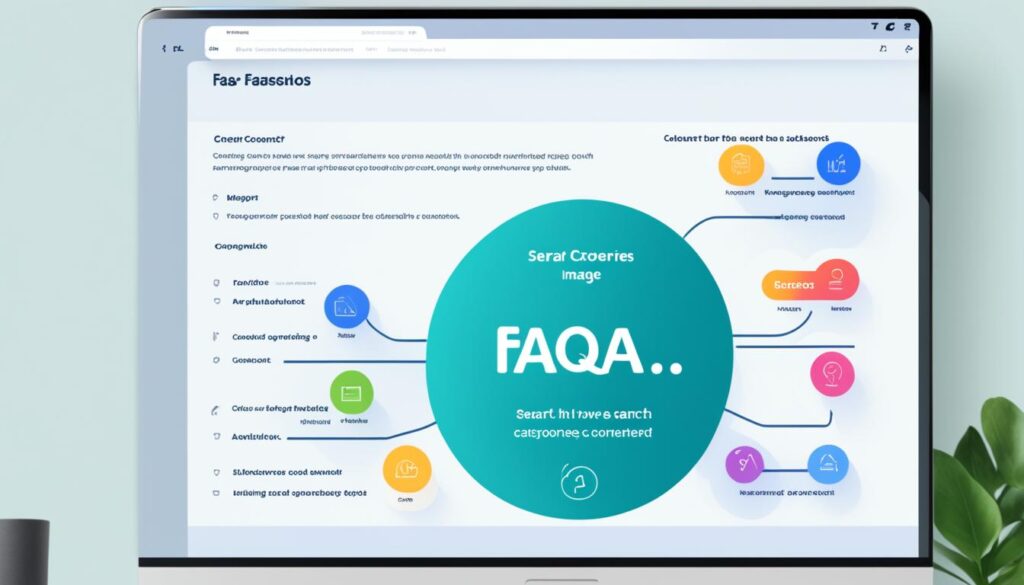An FAQ page is an essential component of any business website. It provides answers to common questions asked by customers, saving time for both the customer and the business. If you’re looking to create your own FAQ page, follow these DIY creation tips.
Use the data from customer service and support to identify common questions. Organize the page effectively, include space for live support options, design the page with clarity and simplicity, publish it on your website, monitor its performance, and update the content regularly. In this article, we will provide you with DIY tips and showcase some of the best FAQ page examples to inspire you.
Creating a user-friendly and informative FAQ page requires careful consideration of design, content strategy, and SEO optimization. By implementing these best practices, you can ensure that your FAQ page enhances the user experience and provides valuable information to your customers.
Identifying Common Questions
To create an effective FAQ page, it is essential to identify the most common questions that customers have about your products, services, and brand. By tapping into your customer service data, you can gain valuable insights into the most frequently asked questions and address them proactively on your FAQ page.
Customer service data is a treasure trove of information that can help you understand your customers’ pain points and concerns. By analyzing this data, you can uncover patterns and trends, allowing you to identify the questions that customers consistently reach out to you with.
To make the most of your customer service data, consider utilizing help desk software with tagging features. These features allow you to categorize and tag customer inquiries based on their nature, enabling you to filter and analyze the data efficiently.
“Analyzing customer data is like having a direct line to your customers’ thoughts and concerns.”
The insights gained from analyzing customer data can help you understand the common challenges faced by your customers. This knowledge enables you to develop comprehensive and informative answers to address these questions on your FAQ page.
By effectively utilizing your customer service data and employing help desk software with tagging features, you can ensure that your FAQ page addresses the most frequently asked questions and provides valuable information to your customers.
Now that you understand the importance of identifying common questions and tapping into customer data, let’s move on to the next section where we will discuss how to organize your FAQ page for optimal user experience.

| Benefits of Identifying Common Questions | Effective Strategies |
|---|---|
|
|
Organizing Your FAQ Page
Once you have identified the common questions, it’s important to organize your FAQ page in a way that is easy for customers to navigate. Consider the structure of your FAQ page, whether it should consist of a single page or multiple pages linked together. Utilize a navigation bar and search bar to provide easy access to the answers. Categorize the questions into relevant topics and use searchable keywords in your titles and content to make the page easier to find.
Structuring Your FAQ Page
Determining the structure of your FAQ page is crucial to ensure a smooth user experience. You have two options: a single page FAQ or a multi-page FAQ. A single page FAQ is suitable for businesses with a smaller number of questions, allowing customers to quickly scroll through them. On the other hand, a multi-page FAQ is ideal for websites with a vast amount of information, where questions are organized into different categories and linked together to provide easy access.
Navigation and Search Bar
Include a navigation bar at the top or side of your FAQ page to allow users to jump to specific categories or sections. This allows for quicker navigation and helps users find the information they need without scrolling through the entire page. Additionally, incorporate a search bar that enables users to search for keywords or phrases related to their query. This saves time and provides a more efficient way of accessing answers.
Categorizing and Tagging Questions
To improve the user experience, categorize your questions into relevant topics. This allows users to navigate through the FAQ page more easily and find answers specific to their needs. Use clear and descriptive labels for each category. Additionally, incorporate searchable keywords in your titles and content to make the page easier to find through search engines.
| Category | Number of Questions |
|---|---|
| Product Information | 22 |
| Shipping and Delivery | 15 |
| Account and Login | 10 |
| Payment Methods | 12 |
| Returns and Refunds | 18 |
By categorizing the questions and providing a clear structure, you make it easier for customers to find the information they need, resulting in a more satisfying user experience.

With thoughtful organization, a user-friendly navigation bar, and a search function, your FAQ page will provide easy access to answers, enhance customer satisfaction, and save valuable time for both your customers and your business.
Incorporating Live Support Options
While an FAQ page serves as an initial support option, it is important to provide live support options for more complex questions. The supplementing FAQ page with support channels such as live chat or phone support allows customers to directly connect with your support team for personalized assistance. This ensures that customers don’t have to navigate away from the FAQ page to reach out for further help.
Direct connection with the support team offers several benefits. It enables real-time communication, allowing customers to resolve their issues quickly and efficiently. Moreover, it adds a human touch to the customer experience, promoting trust and satisfaction.
One effective way to offer live support is by including a support ticket link on your FAQ page. This allows customers to submit their inquiries or problems directly to your support team. Additionally, listing your contact information, such as a phone number or email address, provides customers with alternative methods to reach out for assistance.
By incorporating live support options, you enhance the customer experience by providing personalized and immediate assistance when needed, improving customer satisfaction and loyalty.

Support Ticket Example:
| Question Category | Support Ticket Link |
|---|---|
| Product Questions | Submit a Product Inquiry |
| Billing Inquiries | Contact Billing Support |
| Technical Issues | Report a Technical Problem |
With support ticket links for specific question categories, customers can easily submit their inquiries, ensuring they receive the appropriate assistance for their concerns.
Designing Your FAQ Page
Designing an FAQ page is crucial for creating a positive user experience. When visitors arrive at your FAQ page, they are looking for clear and concise answers to their questions. By designing your FAQ page properly, you can ensure that users can easily find the information they need, reducing frustration and improving customer satisfaction.
To create an effective FAQ page design, keep the following tips in mind:
- Provide clear and concise answers: When answering each question, strive to provide a straightforward and easily understandable response. Avoid jargon or overly technical language that may confuse your users.
- Regularly update the content: It’s important to keep your FAQ page up to date. Review the questions and answers regularly to ensure they are accurate and relevant. Adding new questions based on customer feedback or emerging trends can also enhance the usefulness of your FAQ page.
- Include a search bar: Incorporate a search bar at the top of your FAQ page to make navigation easier for users. This feature allows visitors to quickly search for specific topics or keywords, saving them time and effort.
- Organize questions by category: Divide your FAQ page into categories based on the topics or themes of the questions. This way, users can easily navigate to the relevant section and find the information they need without scrolling through a long list of questions.
- Link the top questions: Identify the most frequently asked questions and link them at the top of your FAQ page. This feature allows users to access the essential information quickly and efficiently.
- Stick to a basic design: Keep the design of your FAQ page simple and clean. Use a clear font, appropriate spacing, and minimal distractions. This approach ensures that users can read the content easily and focus on finding the answers they’re seeking.
By following these design principles, you can create an FAQ page that delivers a seamless user experience and provides the information your customers are looking for.
Examining FAQ Page Examples
Need some inspiration for creating your own FAQ page? Take a look at these well-designed and user-friendly FAQ pages:
Zappos: Zappos’ FAQ page keeps it simple with a limited number of questions and answers. Each question leads to a micro-blog post with helpful hyperlinks, allowing customers to explore further if needed.
Dropbox: Dropbox offers a clear and easy-to-navigate FAQ page. It includes a search bar for quick access to specific questions, a sidebar menu for easy navigation through categories, and a section highlighting the top questions customers ask.
Bank of America: Stand out with Bank of America’s state-specific options on their FAQ page. Customers can select their location for more targeted information. The page also features a convenient search bar to find answers quickly.
Etsy: Etsy’s FAQ page is informative, straightforward, and aesthetically pleasing. The page is well-organized, with questions categorized for easy navigation. The clean design and concise answers make it easy for users to find the information they need.
Adobe Creative Cloud: Adobe Creative Cloud’s FAQ page provides multiple search options, including a search bar and categories to browse through. It also ends with a request for reader feedback, demonstrating a commitment to improving the customer experience.
These examples showcase the importance of creating a clear and concise FAQ page that is organized and user-friendly. By organizing questions by category, incorporating search options, and providing easy navigation, these companies offer excellent models for you to follow.
FAQ
How do I create an effective FAQ page?
To create an effective FAQ page, start by identifying the most common questions customers have about your products, services, and brand. Utilize your customer service data to analyze frequently asked questions. Organize your FAQ page in a logical structure, using a navigation bar and search bar for easy access. Categorize questions into relevant topics and use searchable keywords for better visibility. Finally, regularly update the content to keep it accurate and relevant.
How can I identify common questions for my FAQ page?
You can tap into your customer service data to identify common questions. Utilize help desk software with tagging features to categorize and analyze the data. This will give you insights into the frequently asked questions that should be addressed on your FAQ page.
How should I organize my FAQ page?
Organize your FAQ page in a way that is easy for customers to navigate. Consider the structure of your FAQ page, whether it should consist of a single page or multiple pages linked together. Utilize a navigation bar and search bar to provide easy access to the answers. Categorize the questions into relevant topics and use searchable keywords in your titles and content to make the page easier to find.
Should I include live support options on my FAQ page?
Yes, it is important to provide live support options for more complex questions. Incorporate links or contact information for customers to directly connect with your support team. This can include adding a support ticket link or listing the phone number of your call center. By offering these options, customers don’t have to navigate away from the FAQ page to reach out for further assistance.
How should I design my FAQ page for a positive user experience?
Designing an FAQ page is crucial for a positive user experience. Provide clear and concise answers to each question to avoid confusion. Regularly update the content to keep it accurate and relevant. Include a search bar for easy navigation through the questions. Organize the questions by category to make it easier for users to find what they’re looking for. Link the top questions for quick access. Stick to a basic design that is easily readable and accessible.
Can you provide examples of well-designed FAQ pages?
Certainly! Here are some examples of well-designed and user-friendly FAQ pages:
– Zappos: They keep it simple with a handful of questions and answers, each leading to a micro-blog with helpful hyperlinks.
– Dropbox: They offer a clear and easy-to-navigate FAQ page with a search bar, sidebar menu, and top questions.
– Bank of America: Their FAQ page stands out with its state-specific options and convenient search bar.
– Etsy: Its FAQ page is informative, straightforward, and aesthetically pleasing.
– Adobe Creative Cloud: Their FAQ page provides several search options and ends with a request for reader feedback.
These examples demonstrate how to create a clear and concise FAQ page that is organized and easy to navigate.
